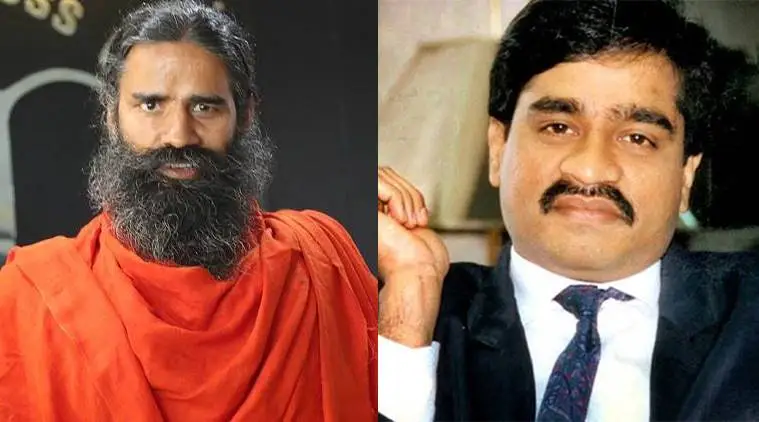Opinion Dawood Ibrahim to Baba Ramdev, why death hoaxes go live on social media’s fake news highway
The desire to “break” news quickly is the psychological driver that frequently motivates people to forward fake news in their circles without verification.

 Baba Ramdev and Dawood Ibrahim — two figures “killed off” last week in Whatsapp hoaxes.
Baba Ramdev and Dawood Ibrahim — two figures “killed off” last week in Whatsapp hoaxes.
Last week, Whatsapp hoaxes buzzingly claimed that Dawood Ibrahim was dead from a “massive heart attack” and that Baba Ramdev had died in an accident on the Mumbai-Pune highway, until they were effectively debunked by various sources, including by Chhota Shakeel in case of Ibrahim and the alive-and-kicking man himself, in case of Ramdev. The photo claiming to depict Ramdev’s car accident turned out to be from another event that took place in Bihar and his own stretcher-ridden images were dated from 2011 when his health had taken a dramatic downturn on the seventh day of a fast-unto-death.
Death hoaxes focusing on well-recognised personalities and popular celebrities are a genre with an enduring, dependable appeal all over the world — they make for great drivers of digital traffic. While propagation of fake news and rumors are as old as time, the arrival of the social media and instant messaging have lent a new meaning to the saying that “A lie can travel halfway around the world while the truth is still putting on its shoes”. Sometimes these rumors even find their way into mainstream digital media through a network effect.
As for Whatsapp, it is by far the most popular service in India (200 million users) by the virtue of its speed and ease. It is also a more intimate and age-proof social channel that sustains weak ties through its groups that frequently connect close and distant family members as well as groups of acquaintances who may not otherwise know one another too well.
“Most misinformation that originates within Whatsapp finds its way through this tight-knit network of weak ties,” Harsh Taneja, an assistant professor at the Missouri School of Journalism whose research focuses on patterns of web use and media audience behaviour, told Buzzfeed Tech News. Whatsapp groups containing a large number of people, who do not otherwise interact a lot with one another, serve as a breeding ground for quick forwarding and receiving of circulating messages, including potentially malicious or fake ones. Speaking on Whatsapp’s notoriety for spreading fake news, Bal Krishn Birla, founder of check4spam.com, an Indian platform with a mission to check and bust Whatsapp-based fake news and hoaxes, says, “People don’t assign ownership of the image to you, in the way that it is if you post something on say, Facebook. Whatsapp and its concept of forwarding and receiving is the biggest hoax spreader because you can always hold up your hands and say, I received it, so I forwarded it”. Hence the domino effect of misinformation through Whatsapp is the greatest
According to Birla, the three largest categories of Whatsapp-based fake news directed by users for fact check towards Check4spam.com can be divided into three categories — they are either ideological in nature (for example, nationalistic, political or lingual) or scams with some economic/malicious motive or the nuisance variety that are often inaccurate and attention grabbing but lack an ulterior motive.
Birla categorises death hoaxes like that of Ramdev’s accident in the nuisance category which manipulate and misrepresent images out of context. “One of the biggest things in Whatsapp is that it strips out all the image attributes”, says Birla, “The image file of a photo from your mobile contains all the information — location, focal length, phone type. Whatsapp basically strips out all that from the file in order to work on lower bandwidth, so an image from Whatsapp is not traceable”, he says. Further, Whatsapp messages are encrypted end-to-end, which makes it practically impossible to track the spread of concerning content like fake news.
Human tendencies that spread fake news:
The desire to “break” news quickly is the psychological driver that frequently motivates people to forward fake news in their circles without verification. When it comes to popular celebrities, hoaxes also strike an emotional chord with their unwitting proponents.
Viral messages work on the muscle of human tendency to believe and spread “news” when they confirm our pre-existing biases, tap into our fears or strike an emotional chord. For example, a popular ideological hoax stated that Bhagat Singh was martyred on the day that Indians are celebrating as Valentine’s Day, which was only well-travelled misinformation as the former is 23rd March — marked as Shaheed Diwas — and the latter is 14th February. Another example is the hoax that UNESCO declared Jana Gana Mana as the best national anthem or Kannada the best language. Facts notwithstanding, if people identify with the ideology behind these messages, they may be tempted to forward it. Deeply divisive events of last last year like Brexit and US Presidential elections similarly saw a huge surge in fake news, conspiracy theories and pseudoscience discourses over social media. The reason they got so mainstream was again their strong catering to confirmation bias of the targeted populace.
Fear is another rather common trigger for sharing behavior. In 2015, Mumbai police commissioner had set up a rumor debunking hotline for anxious parents in the wake of Whatsapp based rumors that gangs of women were kidnapping school children. It is not surprising that in a world with unabating troubling outbreaks and sensation news headlines, where personal security can seem uncertain and breachable, fear-breeding messages spread very quickly.
A study by social psychologists Nicholas DiFonzo and Prashant Bordia, documented in their academic text Rumor Psychology: Social and Organizational Approaches, reveals that uncertainty trumps over happiness and surprise as a viral emotion. This has consequences for fake news as uncertainty can give rise to anxiety and fear, which generates an ideal climate for rumors to fly. For instance, in 2011, rumors started circulating in India that Delhi Police had issued a notice that a worker of Frooti had leaked their blood into the beverage, which could spread the virus upon consumption. Ebola crisis in 2015 similarly let a large number of hoaxes loose globally.
Death hoaxes, however horrible as pranks, are perhaps the relatively harmless tip of the fake news iceberg but social media is increasingly becoming the way we consume news. While it is great to have information and drawn analysis at one’s fingertips, the consequences of inaccurate, biased and manipulated information can have real-life harmful impact. So while it is tempting to forward messages out of concern for loved ones or to show one’s grip on current affairs, make sure to keep calm and check your facts.






